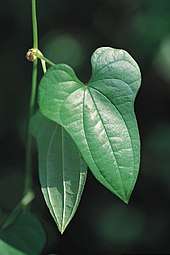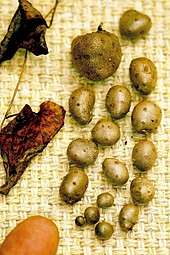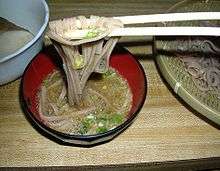Chinese yam
Dioscorea polystachya or Chinese yam (Chinese: 山药), also called cinnamon-vine,[2] is a species of flowering plant in the yam family. It is sometimes called Chinese potato or by its Japanese name nagaimo.[3][2]
| Chinese yam | |
|---|---|
.jpg) | |
| Scientific classification | |
| Kingdom: | Plantae |
| Clade: | Tracheophytes |
| Clade: | Angiosperms |
| Clade: | Monocots |
| Order: | Dioscoreales |
| Family: | Dioscoreaceae |
| Genus: | Dioscorea |
| Species: | D. polystachya |
| Binomial name | |
| Dioscorea polystachya | |
| Synonyms[1] | |
It is a perennial climbing vine, native to China and East Asia.[3][4] The edible tubers are cultivated largely in Asia and sometimes used in alternative medicine. This species of yam is unique as the tubers can be eaten raw.[5][6]
Range
This plant originating in China now grows throughout East Asia (Japan, Korea, Kuril Islands, Philippines, Vietnam).[7] It is believed to have been introduced to Japan in the 17th century or earlier.[8] Introduced to the United States as early as the 19th century for culinary and cultural uses, it is now considered an invasive plant species.[7][9][10][11] The plant was introduced to Europe in the 19th century during the European Potato Failure, where cultivation continues to this day for the Asian food market.[12]
Taxonomy
The botanical names Dioscorea opposita and Dioscorea oppositifolia have been consistently misapplied to Chinese yam.[2][5][11] The name D. opposita is now an accepted synonym of D. oppositifolia.[13] Botanical works that point out the error may list, e.g., Dioscorea opposita auct. as a synonym of D. polystachya.[2] Furthermore, neither D. oppositifolia nor the prior D. opposita have been found growing in North America and have no historical range in China or East Asia, this grouping is native only to the subcontinent of India and should not be confused with Dioscorea polystachya.[5]
Description

Dioscorea polystachya vines typically grow 3–5 meters long, but can be longer. They twine clockwise. The leaves are up to 11 centimeters long and wide. They are lobed at the base and larger ones may have lobed edges. The arrangement is variable; they may be alternately or oppositely arranged or borne in whorls. In the leaf axils appear warty rounded bulbils under 2 centimeters long. The bulbils are sometimes informally referred to as "yam berries" or "yamberries". [14][15]
New plants sprout from the bulbils or parts of them.
The flowers of Chinese yam are cinnamon-scented.
The plant produces one or more spindle-shaped[5] or cylindrical[11] tubers. The largest may weigh 10 pounds and grow one meter underground.[11] Dioscorea polystachya is more tolerant to frost and cooler climates than other yams, which is attributed to its successful introductions and establishment on many continents.
Common names

In Chinese it is known as huáishān (怀(淮)山),[16] shānyào (山药, 山藥) (lit. "mountain medicine."), or huáishānyào (怀(淮)山药, 怀(淮)山藥)(lit. "mountain medicine from Huai", i.e. Huai Qing Fu (怀庆俯) region). Rarely, also referred to as shǔyù (薯蕷). The yam bulbils are referred to as shanyao dou 山药豆, i.e. "yam beans", or shanyao dan 山药蛋 ("yam eggs").
In Japan, three groups of this species in cultivation are recognized. The common long, cylindrical type is known as nagaimo (lit. 'long yam'; kanji: 長芋). The ichōimo (銀杏芋) 'ginkgo-leaf yam' bears a flat, palmate shape, and the tsukune imo (つくね芋) 'meatball yam' is round or globular.[17][18] The term yamatoimo (大和芋) 'Yamato [Province] yam' is used particularly in the Kantō region for the ichōimo in the market,[19] but this is confusing since traditionally yamatoimo has also referred to tsukuneimo, especially if produced in Yamato Province (now Nara Prefecture).[20] Cultivars of this species (such as yamatoimo) is sometimes called "Japanese mountain yam",[21] though that term should properly be reserved for the native Dioscorea japonica.[8]
In Korea it is called ma (hangul: 마), "sanu (山芋, 산우)", seoyeo (薯蕷, 서여), or sanyak (山藥, 산약) and in Sri Lanka in Sinhala it is called wal ala (වැල් අල). Sometimes called Korean yam.
In Vietnam, the yam is called củ mài or khoai mài. When this yam is processed to become a medicine, the yam is called hoài sơn or tỳ giải.
In the Ilocano of the northern Philippines it is called tuge.
In Latin American countries it's known as white name or white ñame.
In Manipuri it is called as "Ha".
In alternative medicine
Creams and dietary supplements made from the related Dioscorea villosa are claimed to contain human hormones and promoted as a medicine for a variety of purposes, including cancer prevention and the treatment of Crohn's disease and whooping cough. However, according to the American Cancer Society, the claims are false and there is no evidence to support these substances being either safe or effective.[22] Huáishān has also been used in traditional Chinese medicine.[23]
As an invasive species
Dioscorea polystachya was introduced to the United States in the 1800s when it was planted as an ornamental or food crop. It and other introduced yam species now grow wild there. It is troublesome in Great Smoky Mountains National Park, where its range is "rapidly expanding".[11] It is most prevalent in moist habitat types. It is more tolerant of frost than other yams and can occur in temperate climates as far north as New York.[11][24]
Uses
.jpg)
The tubers of D. polystachya can be eaten raw (grated or sliced[25]), while most other yams must be cooked before consumption (due to harmful substances in the raw state).[17]
First the skin needs to be removed by peeling (or by scraping off using a hard-bristled brush).[26][27] This may cause a slight irritation to the hand, and wearing a latex glove is advised, but if an itch develops then lemon juice or vinegar may be applied.[27][25]
The peeled whole tubers are briefly soaked in a vinegar-water solution, to neutralize irritant oxalate crystals found in their skin,[17] and to prevent discoloration.[26] The raw vegetable is starchy and bland, mucilaginous when cut or grated,[28][25] and may be eaten plain as a side dish, or added to noodles, etc.
Japanese cuisine

In Japanese cuisine, both the Chinese yam cultivars and the Japanese yam (often wild foraged) are used interchangeably in dishes. The difference is that the nagaimo tends to be more watery, while the native Japanese yam is more viscous.[29]
The tororo is the mucilaginous purée made by grating varieties the Chinese yam (nagaimo, ichōimo, tsukuneimo)[17] or the native Japanese yam.[30] The classic Japanese culinary technique is to grate the yam by grinding it against the rough grooved surface of a suribachi, which is an earthenware mortar.[31] Or the yam is first grated crudely using an oroshigane grater, and subsequently worked into a smoother paste in the suribachi using a wooden pestle.[32]
The tororo is mixed with other ingredients that typically include tsuyu broth (soy sauce and dashi), sometimes wasabi or green onions,[33][34] and eaten over rice or mugimeshi (steam-cooked blend of rice and barley).[17][35][29]
The tororo poured over raw tuna (maguro) sliced into cubes is called yamakake, and eaten with soy sauce and wasabi.[33]
The tororo may also be poured over noodles to make tororo udon/soba.[29] Noodles with grated yam over it is also called yamakake.[26]
Grated yam is also used as binding agent in the batter of okonomiyaki.[29]
Sometimes the grated yam is used as an additive for making the skin of the manjū confection, in which case the product is called jōyo manjū (薯蕷饅頭) 'yam manjū'.[36][37] The yam is also used in the making a regional confection called karukan, a specialty of the Kyūshū region.[29]
Chinese cuisine
Chinese yam is referred to as shānyào (山药 / 山藥) in Chinese and the tuber is consumed e.g. raw, steamed or deep-fried.
Korean cuisine
In Korea, there are two main types of Chinese yam: The straight, tube-shaped variant is called jangma (장마 - "long ma"), while danma (단마 - "short ma") refers to the variant, which grows shorter, cluster-like tubes.[38] Both are used in cooking and the tubers are prepared in a variety of ways. They are most commonly consumed raw, after the skinned roots have been blended with water, milk or yogurt (occasionally with additional honey) to create a nourishing drink known as majeup (마즙) or "ma juice" (마주스). Alternatively, the peeled tubers are cut into pieces and served - either raw, after cooking, steaming or frying - together with seasoning sauces.
Growing Chinese yam
The Chinese yam's growing cycle spans approximately one year, and should be planted between winter and spring. The traditional methods growing it are: using smaller tubers, top cut of bigger tubers or through cuttings of branches. The first two methods can produce 20 cm (7.8 in) long tubers and above. The latter produces smaller tubers (10 cm or 4 in) that are usually replanted for the next year.
Between 7 and 9 months of replanting Chinese yam tubers, their leaves start to get dry (a common fact in plants that grow tubers): that indicates that it's time to harvest. In home gardens generally only what will be consumed is harvested, with the rest left in the pot in moist soil.[39]
See also
- Yam (vegetable)
- Dioscorea oppositifolia
- Dioscorea villosa
- Diosgenin
- List of ineffective cancer treatments
- Tremella fuciformis
References
- Citations
- "Dioscorea polystachya". World Checklist of Selected Plant Families (WCSP). Royal Botanic Gardens, Kew. Retrieved 1 February 2014.
- "Dioscorea polystachya". Germplasm Resources Information Network (GRIN). Agricultural Research Service (ARS), United States Department of Agriculture (USDA). Retrieved 17 December 2017.
- Wiersema, John H.; León, Blanca (2016). World Economic Plants: A Standard Reference, Second Edition. CRC Press. p. 837. ISBN 9781466576810.
- Xu, Zhenghao; Chang, Le (2017). Identification and Control of Common Weeds. 3. Zhejiang University Press / Springer. p. 899. ISBN 9789811054037.
- Raz, Lauren (2002). "Dioscorea polystachya". In Flora of North America Editorial Committee (ed.). Flora of North America North of Mexico (FNA). 26. New York and Oxford – via eFloras.org, Missouri Botanical Garden, St. Louis, MO & Harvard University Herbaria, Cambridge, MA.
- Ting, Chih-chi; Gilbert, Michael G. "Dioscorea polystachya". Flora of China. 24 – via eFloras.org, Missouri Botanical Garden, St. Louis, MO & Harvard University Herbaria, Cambridge, MA.
- "Chinese yam" at the Encyclopedia of Life

- Tsuyuzaki, Shiro 露崎四朗. "Dioscorea polystachya Turczaninow". (TSUYUZAKI Shiro. Hokkaido University. Archived from the original on 28 May 2015. Retrieved 1 February 2016.
- "Forest Invasive Plants of the Northeastern Area - Chinese Yam or Cinnamon Vine". na.fs.fed.us. Retrieved 2016-02-01.
- Invasive Plant Atlas of the United States, entry for Dioscorea polystachya
- Gucker, Corey L. (2009). "Dioscorea spp". Fire Effects Information System (FEIS). US Department of Agriculture (USDA), Forest Service (USFS), Rocky Mountain Research Station, Fire Sciences Laboratory – via https://www.feis-crs.org/feis/.
- "Chinese Yam (Dioscorea Opposita)". www.onlyfoods.net. Retrieved 2016-02-01.
- "Dioscorea oppositifolia". World Checklist of Selected Plant Families (WCSP). Royal Botanic Gardens, Kew. Retrieved 12 August 2014.
- Christopher, Thomas, ed. (2011), The New American Landscape: Leading Voices on the Future of Sustainable Gardening, Timber Press, p. 121, ISBN 1604691867
- Toensmeier, Eric; Bates, Jonathan (2013), Paradise Lot: Two Plant Geeks, One-Tenth of an Acre, and the Making of an Edible Garden Oasis in the City, Chelsea Green Publishing, pp. 185–188, ISBN 1603583998
- Originated from Jiaozuo (焦作), previously known as "Huai Qing Fu (怀庆俯)" "四大怀药的历史文化渊源". Archived from the original on 2016-02-03. Retrieved 2016-02-01.
- Thompson, Anthony Keith (2014). "Chinese yam". Fruit and Vegetables: Harvesting, Handling and Storage. John Wiley & Sons. p. 1429.CS1 maint: ref=harv (link)
- Babil (2013), p. 101.
- Takahashi, Nobuyuki 高橋伸幸 (2014). "Yamatoimo no tentō ni okeru shōhisha no sentaku yōin" ヤマトイモの店頭における消費者の選択要因. Gunma-ken nōgyō sentā kenkyū hōkoku (in Japanese) (11): 85–86.CS1 maint: ref=harv (link)
- Miyaoi, Yasuo 宮負定雄; Kawana, Noboru 川名登 (1979), Nōgyōyōsgū hoka 農業要集・他: (in Japanese), p. 23
- Satomi, Shinzo (2016). Sushi Chef: Sukiyabashi Jiro. Kodansha USA. pp. 9–22. ISBN 9781942993285.
- "Wild Yam". American Cancer Society. November 2008. Retrieved 21 September 2013.
- Xu, Dermatology in Traditional Chinese Medicine, 2004
- "Dioscorea polystachya". County-level distribution map from the North American Plant Atlas (NAPA). Biota of North America Program (BONAP). 2014.
- Andoh, Elizabeth (2012b). Washoku: Recipes from the Japanese Home Kitchen. Berkeley: Ten Speed Press. p. 64. ISBN 9780307813558.CS1 maint: ref=harv (link)
- Andoh, Elizabeth (2012a). Kansha: Celebrating Japan's Vegan and Vegetarian Traditions. Berkeley: Ten Speed Press. p. 69. ISBN 9781607743965.CS1 maint: ref=harv (link)
- Watanabe, Maki (2019). Asian Salads: 72 Inspired Recipes from Vietnam, China, Korea, Thailand and India. Tuttle. p. 97. ISBN 9781462920839.
- Hu, Shiu-ying (2005). "Yams (Shan-yao 山藥, Shu-yu 薯類) ". Food Plants of China. Chinese University Press. p. 144. ISBN 9789629962296.
- Itoh, Makiko (2015-07-15). "'Yamaimo': Japan's slimy mountain yam". The Japan Times. Retrieved 2019-06-07.
- Davidson, Alan (2016). "Yam". Oxford Companion to Food. p. 883.
- Andoh (2012b), p. 276.
- Takahashi (1990). "The Taste of Japan: The Story of Grated Yam Dishes". The East. 26 (5): 48–49.CS1 maint: ref=harv (link)
- Miyaoi, Yasuo 宮負定雄; Kawana, Noboru 川名登 (1985), Nihon ryōri hiden shūsei: genten gendaigo yaku 日本料理秘伝集成: 原典現代語訳 (in Japanese), 19, p. 88; Defines tororo as "yamatoimo, nagaimo, tsukuneimo, etc. peeled and grated, with dashi sauce flavored using soy sauce, mirin, salt., etc. and adds " yamakake is maguro cut in pieces with tororo poured on top, eaten with wasabi soy sauce".
- Hara, Luiz (2018). The Japanese Larder: Bringing Japanese Ingredients into Your Everyday Cooking. quarto Publishing Group. p. 186. ISBN 9781911127628.
- Belleme, John (1993). Cooking with Japanese Foods: A Guide to the Traditional Natural Foods of Japan. Avery Publishing Group. p. 133.
- Sasaki, Sanmi (2011). Chado the Way of Tea: A Japanese Tea Master's Almanac. Translated by McCabe, Shaun; Iwasaki Satoko. Tuttle. p. 28.
- Tatsuki, Kitsu 田附きつ; Tsukanaka, Kazue 塚中和恵 (1985). "Jōyo manjū no kawa no reōrojī-teki seishitsu" 薯蕷饅頭の皮のレオロジー的性質 [Rheological Properties of the Skin of Bean-Jam Buns Using Yamano-imo]. Gunma-ken nōgyō sentā kenkyū hōkoku (in Japanese). 36 (2): 93–101.CS1 maint: ref=harv (link)
- 지식백과, Naver. "마". Retrieved 11 June 2019.
- Takeguma, Massahiro. "Growing Nagaimo". Retrieved 26 July 2013.
- Bibliography
- Babil, Pachakkil (2013). Kondo, S.; Iwata, H.; Kushikawa, S.; Shiwachi, H. "Intra-specific ploidy variations in cultivated Chinese yam (Dioscorea polystachya Turcz.)". Tropical Agriculture and Developmen. 57 (3): 101–107.CS1 maint: ref=harv (link)
External links
| Wikimedia Commons has media related to Chinese yam. |
- Walck, J. L., et al. (2010). Understanding the germination of bulbils from an ecological perspective: a case study on Chinese yam (Dioscorea polystachya). Ann Bot 106 (6): 945–955.
- Plants for a Future. Dioscorea batatas
- Go Botany, New England Wildflower Society
- Center for Invasive Species and Ecosystem Health, Chinese yam Dioscorea polystachya Turcz.